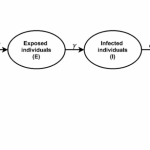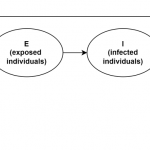Mathematical modeling and prediction of the COVID-19 spread in Russia
The aim of the project is to develop a novel methodology and software tools for mathematical modeling and dynamic prediction of the COVID-19 spread in Russia

Task
The emergence of the novel SARC-CoV-2 coronavirus in 2019 has necessitated the development and utilization of analytical tools for the operational analysis, modeling, and prediction of the COVID-19 spread in the Russian Federation.
The results of the work are essential for the assessment of the required resources of the healthcare system in the short and medium term. This assessment is necessary in order to predict the effect of introducing or removing restrictions related to the containment of the infection. Digital modeling techniques provide data to inform management decisions aimed at eliminating COVID-19 outbreaks with minimal epidemiological, social, and economic damage.
In order to provide instrumental and expert support for countering COVID-19, a working group to predict the COVID-19 spread in Russian regions was established on February 3, 2022, on the basis of the NTI Competence Centre of SPbPU under the direction of A.I. Borovkov in coordination with the Ministry of Health of the Russian Federation. The working group comprised specialists and experts from the NTI Competence Centre and the Institute of Biomedical Systems and Biotechnology of SPbPU, the Smorodintsev Research Institute of Influenza, the Institute of Economic Forecasting of the Russian Academy of Sciences, and the Faculty of Economics of Lomonosov Moscow State University.
The outcome of this research is a family of digital models of the COVID-19 spread, with consideration of a range of significant factors that affect the behavior of the system as well as the software that implements them. The developed models permit the extent, speed, and impact of the COVID-19 spread in the Russian regions to be foreseen in advance, with consideration given to a range of countermeasures to be taken against the spread of the virus.
The methodological foundations of digital modeling in socioeconomic systems were also created and developed in the course of the work.
Solution
The distinctive feature of the project lies in the methodology proposed to model complex processes in socioeconomic systems, including the spread of the COVID-19 virus.
The proposed methodology is founded upon the integration of conventional modeling techniques for socioeconomic systems with those inherent to contemporary engineering projects within the advanced manufacturing technology paradigm. These include dynamic prediction, interval approach, sensitivity analysis, calibration, verification, and validation. Previously, these tools were used primarily for technical systems. Their application in the field of socioeconomic systems modeling has not been widespread due to the lack of established methodological foundations. The approach developed within the COVID-19 Coronavirus Infection Mathematical Modeling and Forecasting project has become one of its foundational pillars.
As part of the project implementation, the following have been developed:
- A family of population and spatial models for estimating the extent and rate of the COVID-19 spread;
- Models predicting the effects of different COVID-19 countermeasure scenarios in terms of timing, types, and scenarios of control measures;
- Algorithms for predicting epidemiological, social, and economic effects
- Manual and automatic model calibration algorithms to account for data from different times and territories (cities, regions, and countries) for multivariate modeling of the COVID-19 spread;
- Software tools implementing COVID-19 spread models and algorithms for their automatic calibrations.
Although the origins of modeling can be traced back to mathematical models developed during the Spanish flu epidemic over a century ago, modern models have undergone a significant evolution, incorporating a wider range of factors that influence the spread of infectious diseases. These include the number of susceptible, exposed, infected, and recovered individuals, the incubation period, the intensity of effective contacts, restriction and de-restriction scenarios (including self-isolation), socioeconomic indicators, and the implementation or cancellation of methadone treatment.
The project on mathematical modeling and prediction of COVID-19 has significant applied relevance. The predictions of the working group on mathematical modeling and prediction of the COVID-19 spread were used by the authorities of more than 10 regions of the Russian Federation.
Mathematical modeling and prediction of the COVID-19 spread have led to the formation of:
- Control measures and proposals to remove restrictions to counter the COVID-19 spread;
- The assessment of regional healthcare system resources and the timely prediction of regional healthcare system workload and required resources;
- The assessment of the indicator dynamics variability when restrictions are removed;
- Management decisions on the restriction and de-restriction.
In 2020, the ‘Mathematical model for predicting the COVID-19 spread’ project was voted the winner of the Technology Breakthrough Award. During the Technology Breakthrough 2020 final ceremony, the ‘Mathematical model for predicting the COVID-19 spread’ project was commended on behalf of Andrey Belousov, First Deputy Prime Minister of the Russian Federation, as one of the projects that already have or will soon have a platform effect or platform result.

Details
The methodology of simulation modeling, in particular the methods of system dynamics, allows the behavior of a system to be described by taking into account the network of cause-and-effect relationships and identifying functional dependencies between the factors comprising these chains.
The project refined the Kermack–McKendrick SEIR mathematical model that takes into account population categories such as S – Susceptible, E – Exposed, I – Infected and R – Recovered as the most appropriate to describe the behavior of the system given the characteristics of the SARC-CoV-2 virus. Such models are designed to facilitate strategic decision-making with the objective of containing the spread of infectious diseases at the regional or national levels.
The project team developed a number of modifications to the SEIR class models based on the results of their analysis of different configurations of the most relevant factors and modeling objectives.
The SQEIR model and accounting for quarantined or self-isolated persons
In the early months of 2020, when a strategy to contain the disease through self-isolation measures and special regimes for certain industries was on the agenda, a segregation model, SQEIR, was developed to include in the projections a group of individuals (Q) under quarantine or self-isolation. This significantly reduced their ability to become infected. This group of individuals was identified as a distinct category within the broader group of susceptible individuals in accordance with the normative acts of the subjects of the Russian Federation.
A model was constructed with the objective of developing hypothetical scenarios for the introduction or cancellation of control measures. These scenarios were designed to assist in the prediction of the epidemiological situation in Russian regions in instances where self-isolation measures were either introduced or removed.
- Block diagram of the developed SQEIR model
The SVEIRS model and consideration of vaccination and re-morbidity factors
The advent of the next stage of pandemic dynamics in Russia, which necessitated the creation of novel analytical tools, can be tentatively dated to December 2020, when mass vaccination commenced throughout the country.
In the period between December 2020 and February 2021, researchers developed a more up-to-date modification of the simulation model to account for vaccination and morbidity, the SVEIRS model, which was presented in a recent paper.
In addition to the basic population categories typically employed in SEIR models (S – Susceptible, E – Exposed, I – Infected, R – Recovered), the SVEIRS model incorporates an additional category, V – Vaccinated.
The model considers the vaccination process as a means of reducing the incidence of disease by reducing the number of susceptible individuals available for infection, as well as the possibility of re-morbidity as an additional source of susceptible individuals.
- Block diagram of the developed SVEIRS model
The aforementioned alterations have enhanced the precision of predicting the spread of the disease by incorporating variables that significantly influence pandemic dynamics. Consequently, the SVEIRS model can be employed to predict the COVID-19 spread in various geographical regions, thereby enabling the formulation of an optimal vaccination strategy for the population.
Further scientific validation of the SVEIRS model was conducted in order to predict the COVID-19 spread in Moscow between July and September 2022. The SVEIRS model was validated in comparison with the SEVIS reference model, and the results demonstrated that SVEIRS exhibited a higher level of prediction accuracy.
Technologies
| Libraries and frameworks | qt5, pandas, numpy, matplotlib |
| Programming languages | python3.7 |
| OS | Windows 10 |
| Architecture | amd64-compatible |
Partners
Project consortium within the SPbPU NTI Competence Centre (since March 2020):- Working Group of the SPbPU NTI Competence Centre
- Institute of Biomedical Systems and Biotechnology, SPbPU
- Smorodintsev Research Institute of Influenza
- Institute of National Economic Forecasting, RAS
- Moscow State University, Faculty of Economics
Key contributors
- M.V. Bolsunovskaya, Associate Professor at SPbPU, Head of the Industrial Systems for Streaming Data Processing Laboratory, NTI Center, SPbPU
- A.V. Vasin, Acting Director, Institute of Biomedical Systems and Biotechnology, SPbPU
- D.M. Danilenko, Deputy Director for Scientific Work, Smorodintsev Research Institute of Influenza
- V.N. Leonenko, Junior Researcher, Laboratory of Influenza and ARI Epidemiology, Smorodintsev Research Institute of Influenza
- A.M. Gintciak, Head of the Digital Modeling of Industrial Systems Laboratory, NTI Center, SPbPU

